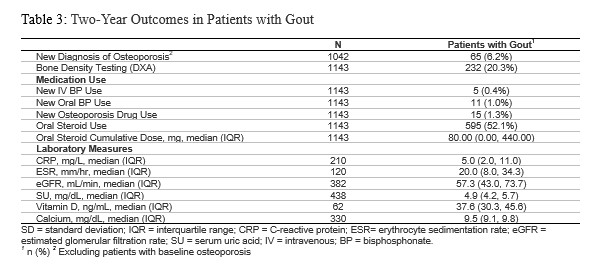Session Information
Date: Monday, November 18, 2024
Title: Osteoporosis & Metabolic Bone Disease – Basic & Clinical Science Poster
Session Type: Poster Session C
Session Time: 10:30AM-12:30PM
Background/Purpose: Gout is an erosive arthropathy, and gout patients have been shown to have a higher occurrence of osteoporosis and fracture. This study evaluated bone health and fracture in gout patients using data from the American College of Rheumatology’s (ACR) Rheumatology Informatics System for Effectiveness (RISE) registry.
Methods: We conducted a retrospective claims-based analysis using the ACR’s RISE registry. Registry data from 2015-2018, linked to 2016-2018 Medicare administrative claims data (full coverage including Medicare parts A, B, and D), were included in analyses. All patients were from active RISE registry sites, were ≥18 years of age at index (January 1, 2017, for all patients), and had no immunomodulator use, malignancy, or other rheumatic disease noted during baseline (1 year period prior to index; Jan-Dec 2016). A gout diagnosis was defined as the presence of ≥1 gout ICD9/10 code with use of a urate-lowering therapy (ULT) or colchicine prior to index. We examined comorbidities and medication use (e.g., oral steroids, hormone replacement therapy [HRT], and NSAIDs) at baseline which included the 12 months prior to and including the index date. Oral steroid use was assessed due to the increased risk of bone weakening. We examined osteoporosis, fractures, and bone protective therapy use during baseline and two years following index (Jan 2017-Dec 2018) to assess bone protective therapy use following any fracture or osteoporosis diagnosis.
Results: We identified 1143 patients with gout applying all inclusion and exclusion criteria (Table 1). Patients were mostly male (62.5%), white (87.5%), and had a median age of 75.0 years. Approximately 90% of patients had a diagnosis of hypertension and 39% were current or former smokers. Included gout patients were frequently treated with ULTs (93.4%) with only 6.6% using colchicine alone. During baseline, 44.7% of patients had ≥1 code for an oral steroid. During the 1-year baseline period, 0.9% of patients with gout had a history of fracture and 8.8% had a history of osteoporosis.
In the two years following the index date, patients with gout experienced a fracture incidence rate of 19.8 per 1,000 patient years (Table 2). When stratified by baseline SU, patients with SU ≥6 mg/dL had a somewhat higher fracture rate than those with SU < 6 mg/dL (19.7 vs. 18.1). In those who did not have a baseline diagnosis of osteoporosis, 6.2% had a new osteoporosis diagnosis in the two years after index. However, very few patients were prescribed IV (< 0.5%) or oral (< 1%) bisphosphonates despite a high prevalence of oral steroid use (52.1%), baseline osteoporosis, and new fracture/osteoporosis diagnoses during follow-up.
Conclusion: Patients with gout commonly experience fractures and are at high risk for osteoporosis but few receive bone protective medications. Strategies to better address bone health awareness among providers and patients with gout may help to prevent bone-related complications and subsequent impact on quality of life.
To cite this abstract in AMA style:
Holladay E, Woods A, Padnick-Silver L, xie F, Zhang J, Gaffo A, Curtis J, LaMoreaux B. Epidemiology of Bone Health and Fracture in Gout Patients [abstract]. Arthritis Rheumatol. 2024; 76 (suppl 9). https://acrabstracts.org/abstract/epidemiology-of-bone-health-and-fracture-in-gout-patients/. Accessed .« Back to ACR Convergence 2024
ACR Meeting Abstracts - https://acrabstracts.org/abstract/epidemiology-of-bone-health-and-fracture-in-gout-patients/



